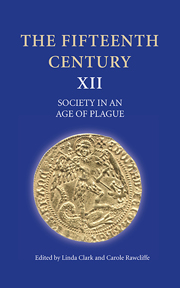Book contents
- Frontmatter
- Contents
- List of Illustrations
- Contributors
- Preface
- Abbreviations
- Introduction
- Looking for Yersinia Pestis: Scientists, Historians and the Black Death
- Pestilence and Poetry: John Lydgate's Danse Macabre
- Pilgrimage in ‘an Age of Plague’: Seeking Canterbury's ‘hooly blisful martir’ in 1420 and 1470
- An Urban Environment: Norwich in the Fifteenth Century
- Mid-Level Officials in Fifteenth-Century Norwich
- Leprosy and Public Health in Late Medieval Rouen
- Plague Ordinances and the Management of Infectious Diseases in Northern French Towns, c.1450–c.1560
- The Renaissance Invention of Quarantine
- Coping with Epidemics in Renaissance Italy: Plague and the Great Pox
- The Historian and the Laboratory: The Black Death Disease
- Index
- CONTENTS OF PREVIOUS VOLUMES
Looking for Yersinia Pestis: Scientists, Historians and the Black Death
Published online by Cambridge University Press: 05 September 2013
- Frontmatter
- Contents
- List of Illustrations
- Contributors
- Preface
- Abbreviations
- Introduction
- Looking for Yersinia Pestis: Scientists, Historians and the Black Death
- Pestilence and Poetry: John Lydgate's Danse Macabre
- Pilgrimage in ‘an Age of Plague’: Seeking Canterbury's ‘hooly blisful martir’ in 1420 and 1470
- An Urban Environment: Norwich in the Fifteenth Century
- Mid-Level Officials in Fifteenth-Century Norwich
- Leprosy and Public Health in Late Medieval Rouen
- Plague Ordinances and the Management of Infectious Diseases in Northern French Towns, c.1450–c.1560
- The Renaissance Invention of Quarantine
- Coping with Epidemics in Renaissance Italy: Plague and the Great Pox
- The Historian and the Laboratory: The Black Death Disease
- Index
- CONTENTS OF PREVIOUS VOLUMES
Summary
The fact that the plague in its bubonic, septicaemic and pneumonic forms is still with us in the twenty-first century often comes as a shock to the general public. Memories of school projects have made them vaguely aware of the great pandemic, which arrived in southern Italy in 1347 and then raged across Europe, reaching England and Norway in 1348, through Oslo in 1348 and then through Bergen in 1349, and European Russia in 1351, where the city state of Novgorod was first infected. But then, surely, it went away? Not quite: outbreaks of plague in this second pandemic, first (allegedly) called the Black Death by Mrs Markham in 1823 in her History of England, from which the horrors of history and the complexities of party politics were removed as not suitable for young minds, lasted in England until the early eighteenth century, whilst in Italy what is generally regarded as its final appearance came at Naja, near Bari, in 1815. Even then the disease did not disappear. It merely became dormant until 1855, when a new pandemic began in China, spreading through the Pacific Rim and in 1899 to the United States where plague had previously been unknown. Indeed, as the well-known World Health Organisation map of plague loci and plague outbreaks 1970–1998 shows, the disease is enzootic or sylvatic (ever-present in certain animal populations and their fleas) in some fifty-eight different regions in the world and can still spread to more susceptible animals, including humans, in epizootic outbreaks.
- Type
- Chapter
- Information
- The Fifteenth Century XIISociety in an Age of Plague, pp. 15 - 38Publisher: Boydell & BrewerPrint publication year: 2013



